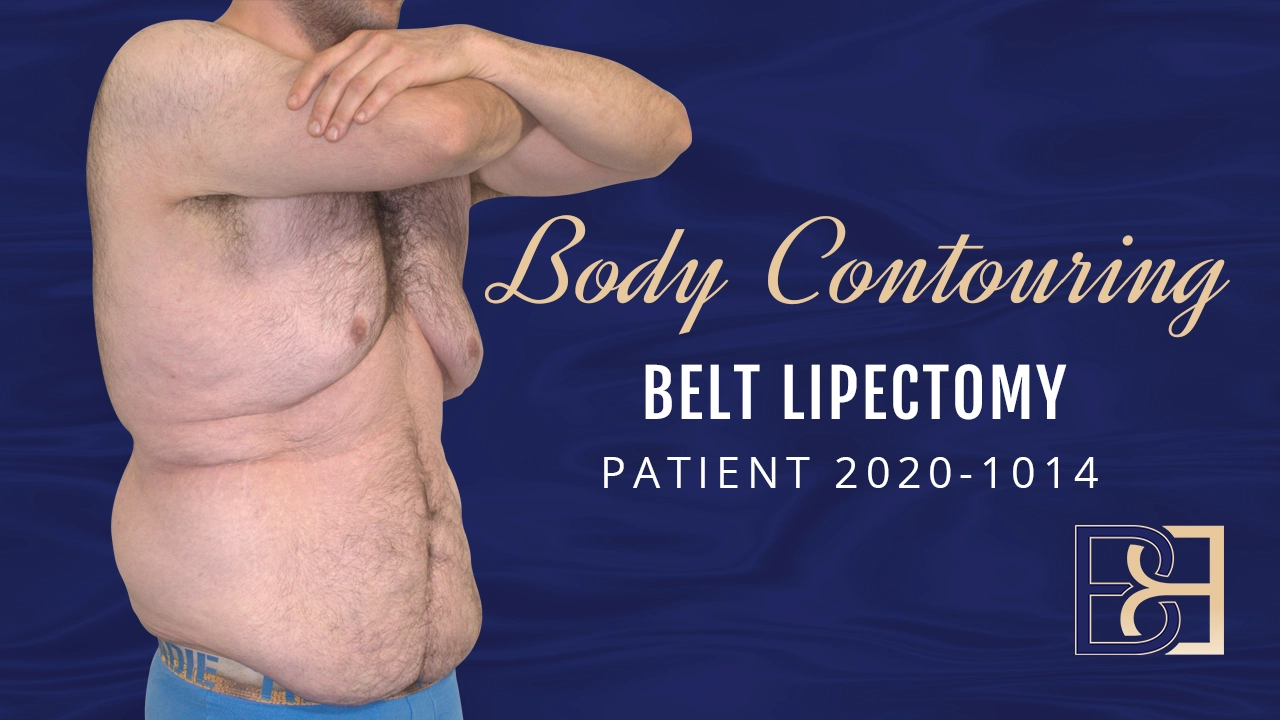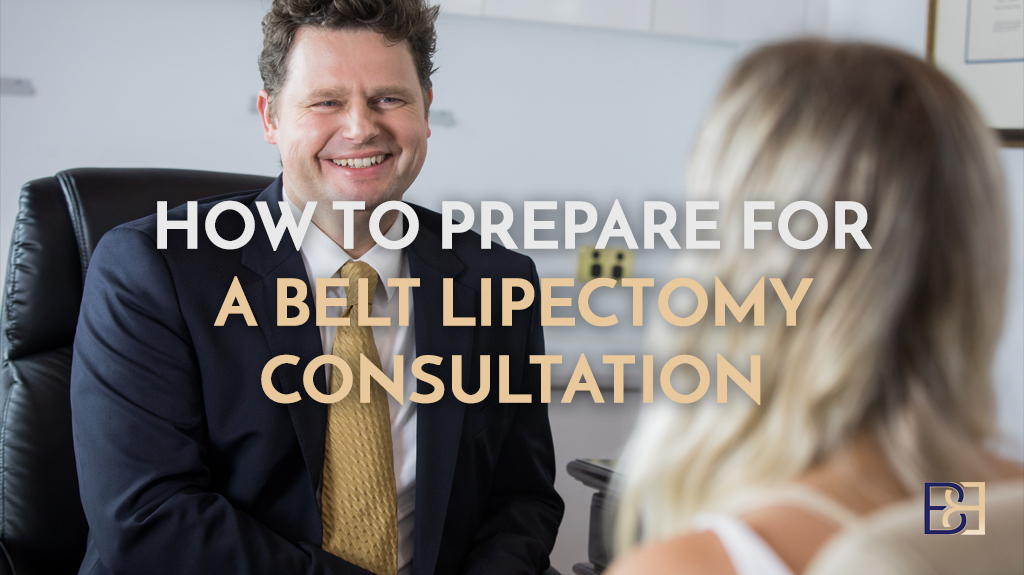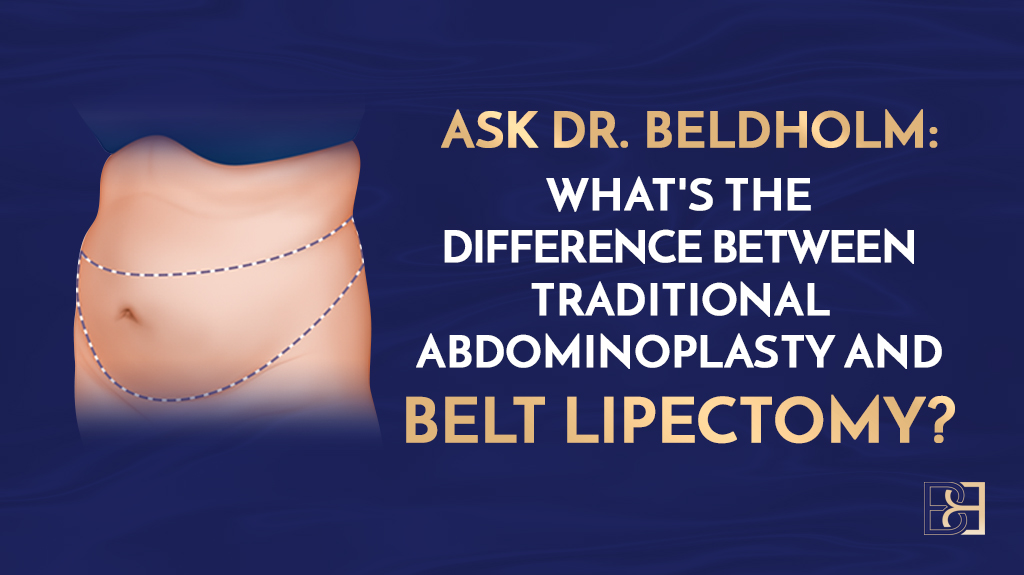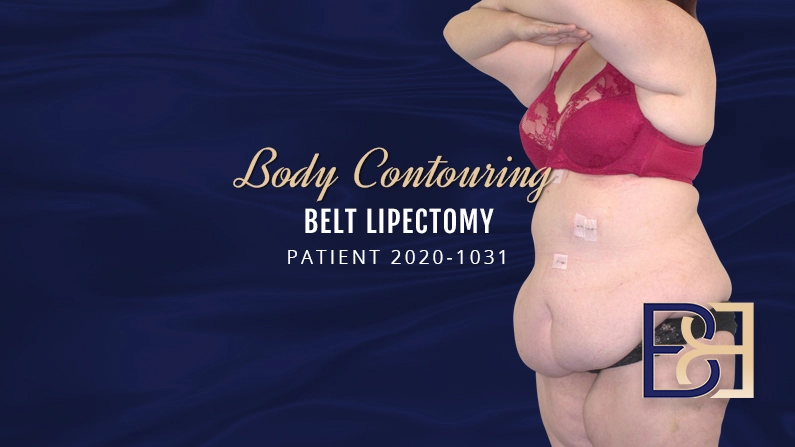After massive weight loss, you may have loose skin around your abdomen, extending 360 degrees. A belt lipectomy is a skin-tightening operation that removes loose skin all the way around your waistline. It lifts and firms your tummy, sides, lower back, mons, buttocks, and thighs in one surgery.
After massive weight loss, a belt lipectomy may be what you need. This article explains how Dr Bernard Beldholm performs a belt lipectomy on a formerly overweight patient with loose skin.
Book your appointment online now
What is a belt lipectomy?
In this section, you will learn exactly what a belt lipectomy does, and how it differs from an abdominoplasty.
What is a belt lipectomy?
A belt lipectomy (body lift) is a body contouring surgery that lifts and tightens ** skin 360 degrees around your abdomen after weight loss. It includes an extended tummy tuck (to tighten skin on your abdomen and sides) and a buttocks lift (to fix loose skin on your bum, thighs and lower back).
What results does a belt lipectomy achieve?
Doctor Bernard’s belt lipectomy is designed to:
- Flatten your abdomen
- Tighten ** thighs
- Lift a ** buttocks
- Correct a ** mons pubis
- Remove excess skin on your lower back
- Fix abdominal muscle separation
What are the benefits of a belt lipectomy?
A belt lipectomy fixes ** skin all the way around your waistline. Instead of having a tummy tuck, buttocks lift and thigh lift as separate operations, they are combined into just one or two surgeries.
Combined operations have several benefits. You can fix loose skin on several areas at once, while likely saving money on hospital fees. You may be able to take less time off work or mum duty to recover, compared to having three or four separate operations, each with a recovery period.
How is a belt lipectomy different from a tummy tuck?
A belt lipectomy and tummy tuck both fix a ** abdomen. Both can include abdominal muscle repair and lipo if you need it.
The difference is a tummy tuck only ** skin laxity on the front of your abdomen. A belt lipectomy extends all the way around your waistline to your back, so it tightens loose skin on your tummy, sides, lower back, mons, buttocks and thighs. The results are more dramatic than a tummy tuck since it tightens multiple areas at once.
Belt lipectomy surgery is usually done after massive weight loss. A tummy tuck can be done after weight loss or pregnancy.
Does a belt lipectomy include lipo?
Not always. Some patients have excess fat, and others do not. A belt lipectomy and tummy tucks are skin-tightening procedures. Liposuction (surgical fat reduction) can be added to your procedure if you also wish to remove stubborn fat. Doctor Bernard can help you decide what you need done.
There is a limit to what lipo of any kind can do. It won’t make you slim if you’re obese. It is done to reshape your curves and get rid of small areas of fat that won’t go away with diet and exercise. If you want to reduce fat bulges during your belt lipectomy, he can perform VASER liposuction to ** your results.
Not all post-weight loss patients have extra body fat. This article will explain how Doctor Bernard performs a belt lipectomy without liposuction.
Note: Click here to see how a belt lipectomy with VASER lipo works.
Who is a good candidate for a belt lipectomy?
Many people have loose skin after weight loss. If you have excess skin all the way around your waistline (front, sides, lower back, buttocks and thighs), you may be a candidate for a belt lipectomy. The procedure is mainly done after massive weight loss (30+ kilos).
To learn if body contouring can help you get the body you want, contact Dr Bernard Beldholm, FRACS, today. He has been helping post-weight loss and post-pregnancy women ** their bodies for more than ten years.
What happens during your belt lipectomy consultation?
After listening to your cosmetic concerns, Doctor Bernard will examine your abdomen, back and sides. He will look for excess skin and/or unwanted fat. After your examination, he will tell you about your treatment options and answer all your questions.
Body contouring surgery is not right for everyone. He will be honest with you about whether a belt lipectomy is right for you. Factors such as your health, cosmetic goals, surgical costs and ability to take time off to recover must all be considered.
His consultation is purely informative. There is no pressure to have surgery. The choice is yours. If you do decide to have a belt lipectomy or other cosmetic procedure, it can be scheduled on a date that works for you.
What can’t a belt lipectomy do?
If you want to tighten ** skin after weight loss, there are many options to consider. During a belt lipectomy, your abdominal tissue needs to remain horizontal and straight. It tightens and lifts your waistline, like pulling your pants up. The skin can’t be pulled to the side, like in other types of abdominoplasty procedures.
Some patients will get a better result with a fleur-de-lis tummy tuck, which ** both vertical and horizontal ** on the abdomen. Doctor Bernard will help you decide if it’s right for your needs during your visit.
Who shouldn’t get a belt lipectomy?
Patient screening is done to make sure you have a ** and successful surgery. Contraindications for surgery can include somatic diseases, active pregnancy, hemophilia, mental impairment or a history of stroke. Smokers will be asked to quit before surgery.
Operation Guide: What happens during a belt lipectomy (without liposuction)?
A belt lipectomy firms and tightens loose skin all the way around your waistline. It makes your tummy, sides, mons, buttocks and thighs firmer and more **. Keep reading to learn what happens in the operating room during Doctor Bernard’s belt lipectomy surgery.
Phase 1: Surgery Prep
Pre-operative appointment
A nurse will ask you to change into a surgical gown. Doctor Bernard will meet with you before you go into surgery. He will answer any last-minute concerns or questions you might have.
Surgical markings
Before you head into surgery, Doctor Bernard will draw on your skin with a marker. You will stand upright in the anaesthetic bay. He draws the markings while you are standing because when you lie down on the operating table, gravity changes everything. He will mark the excess skin on your front, back and sides.
Anaesthesia
A belt lipectomy is performed with a general anaesthetic. There will be no pain, memory or sensation during your surgery The anaesthetist will administer drugs through an IV. You will begin to feel relaxed and sleepy. A breathing tube will be inserted once you are asleep. Once you are sedated and intubated, your surgery will begin. A highly trained anaesthetist will watch over you the whole time. They will monitor your vitals to ensure your **.
Body positioning
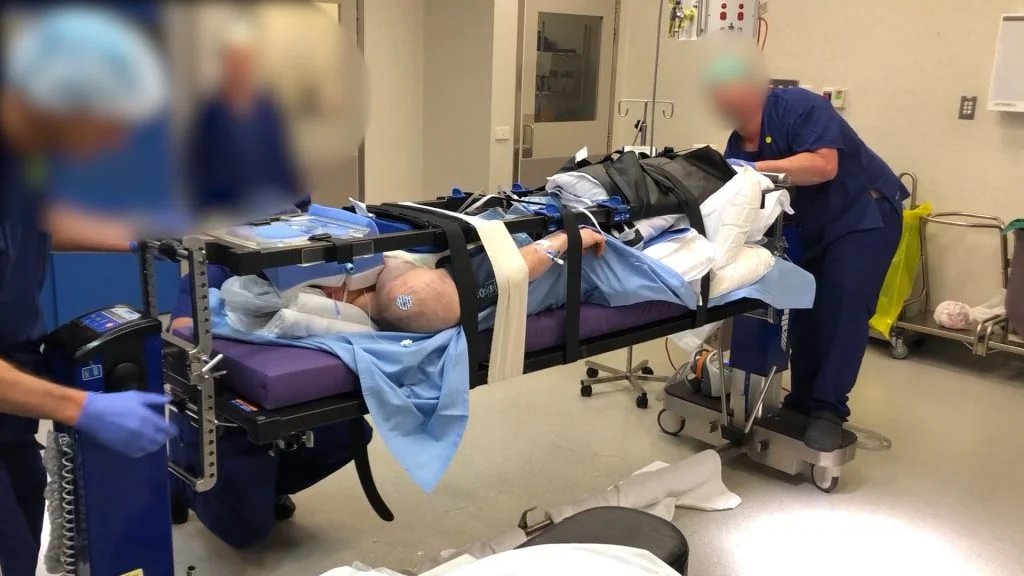
Doctor Bernard will operate on your backside first. You will be positioned on your tummy, lying face down. Later, you will be turned over to access the front of your abdomen.
Special equipment
Doctor Bernard uses specialised operating room equipment for a belt lipectomy. Your face will be cradled in a soft foam block with an opening. Your hips and chest will be placed on foam blocks as well. This frees up your tummy so there is no pressure on your vena cava, which carries blood to and from your heart.
For 360-degree operations, Doctor Bernard uses a special table called a Jackson table. The table makes it easier and ** to turn you over. Instead of doing a manual transfer, which can be risky, the Jackson table turns your body in a controlled manner while you are securely strapped to the bed.
The Jackson table also keeps your tummy free. During a belt lipectomy, you will lie face down for an extended length of time. By avoiding compression on your tummy, your blood vessels can function normally. Abdominal compression can cause strokes and other issues in the brain. That is why it’s important to keep your tummy free during a belt lipectomy so that you’re not lying on your tummy for extended periods.
Phase 2: Lower Back, Buttocks & Thigh Lifting
Doctor Bernard will ** the loose skin on your lower back first. As the extra skin is removed, it helps to lift a ** buttocks and thighs as well.
Incision
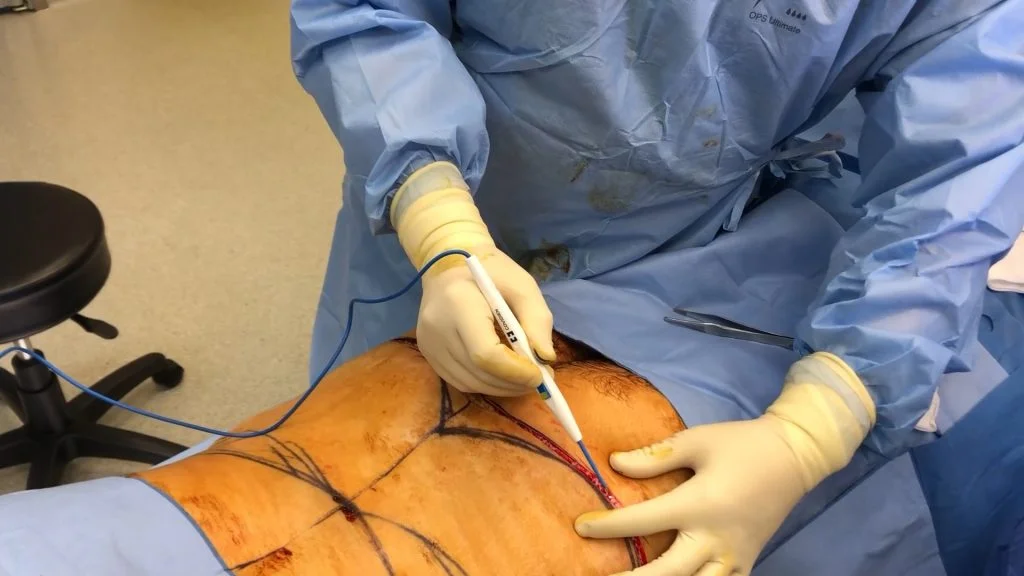
Doctor Bernard will make a long horizontal incision on your lower back, just above your gluteal cleft. The incision will extend from your lower back to the sides of your waist. The markings will guide him as he makes the incision. Every effort is made to ensure your incision is as neat and symmetrical as possible.
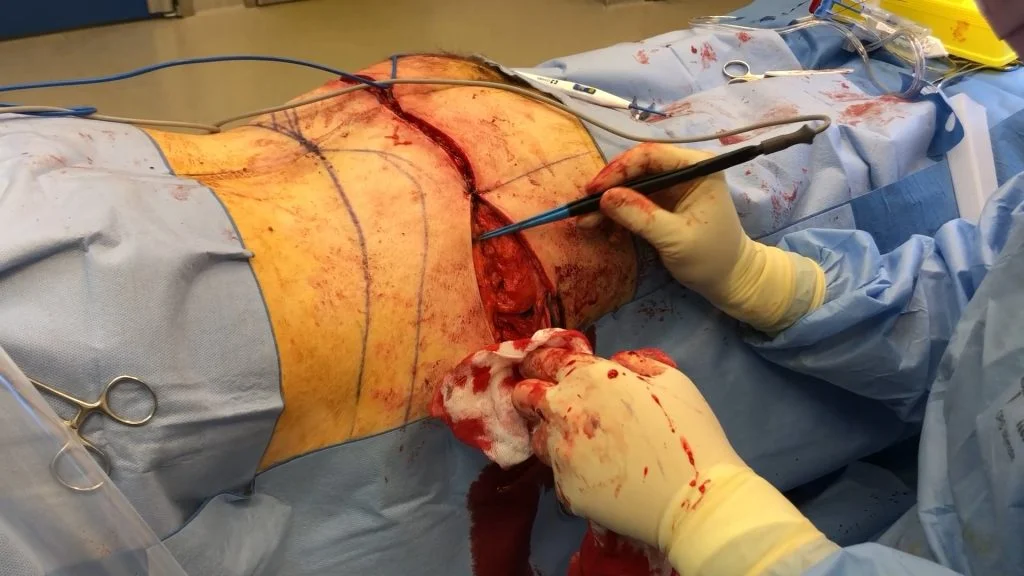
Doctor Bernard will seal each blood vessel he sees. This prevents excessive bleeding, bruising and inflammation during your recovery. Blood in the tissues can be irritating. If a lot of blood pools, it can result in a large bruise (hematoma). Sealing the blood vessels promotes a ** and less-painful recovery.
Skin removal
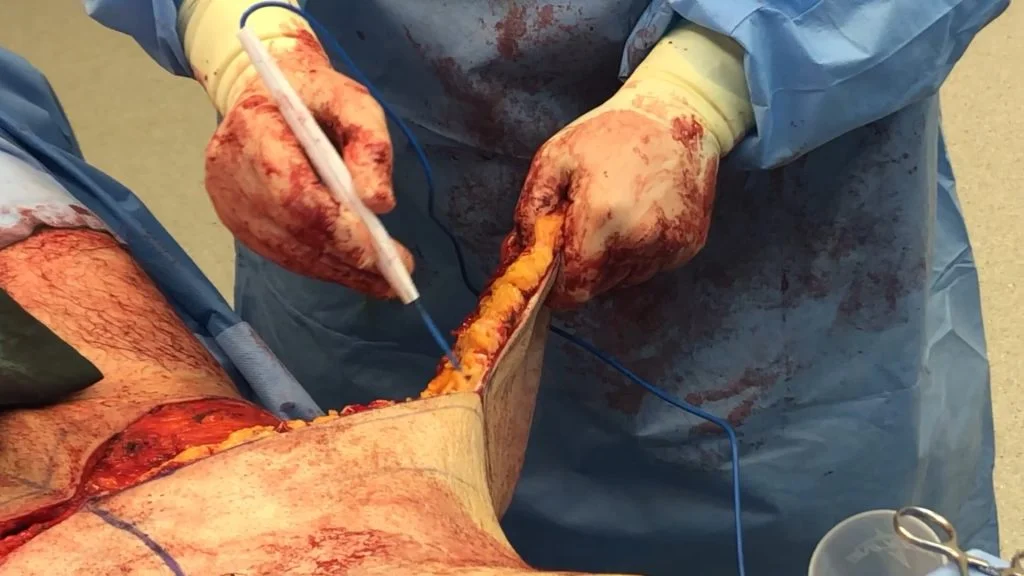
He will remove the loose tissue from your back and sides. Doctor Bernard works in small sections. Each section is about 10 to 12 cm. The cuts have to match up so you get a good-looking scar. Removing your excess skin is a slow and careful process. He aims to remove the correct amount of skin, not too much and not too little. The goal is to tighten your skin as much as possible, while still being able to pull your skin to close the incision without a problem.
Incision closure
After removing the loose skin on your lower back, he will close the incision. As your skin on your lower back is tightened and sutured in place, it lifts and tightens your bum and thighs.
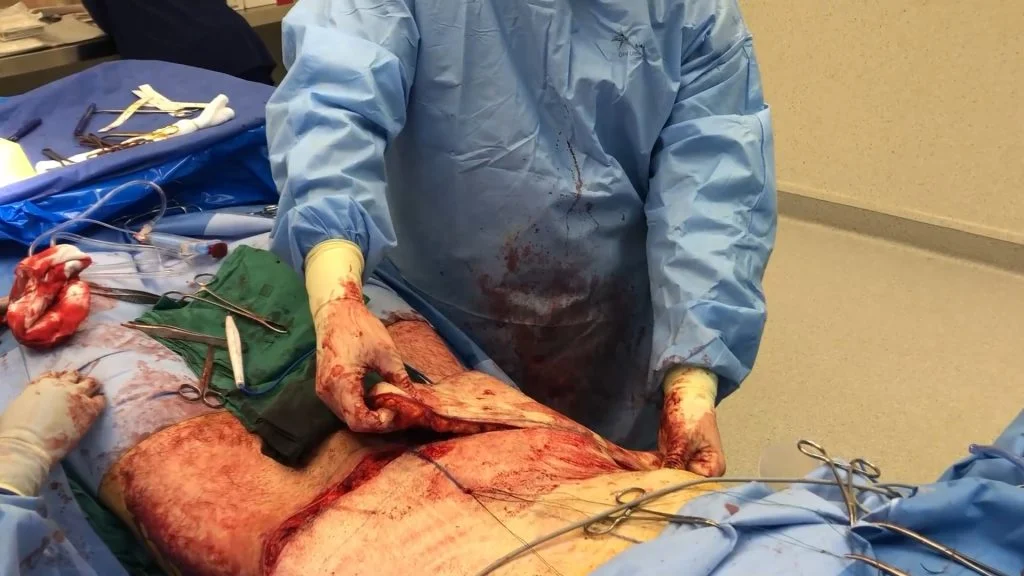
Doctor Bernard will close your incision in layers. These don’t need to be removed. Next, he will apply absorbable sutures. These will dissolve in time, so they won’t need to be removed. Finally, he will close the wound. The closure will be quite tight initially. As you heal, your tissues will relax as the swelling goes down during the first six to twelve months of recovery.
He will also apply a medical-grade glue. This helps seal the layers tightly. It also helps to reduce gaps in your tissues. With a tight seal, blood and clear fluids (both a normal response to surgery) are less likely to pool in your tissues. Glue may minimise the risk of minor complications such as seroma and hematoma.
Phase 3: Turning You Over
Now that your back, bum and thighs are nice and tight, you will need to be turned over to access the front of your abdomen. The turning process takes about one hour. A team of people will assist to ensure you are turned over **. All medical staff are personally trained by Doctor Bernard.
While it takes a team of people, the Jackson table does much of the work. This special table turns you over mechanically. This is considered ** than manual turns or transferring you to another bed.
First, a carbon fiber table frame will be placed above you. You will be strapped to the table. The Jackson table will be locked. The turn will be performed by unlocking the table and rotating the unit 180 degrees. After the turn is done, you will be lying face down. Your body will be strapped and repositioned. Doctor Bernard will then tighten the skin on your tummy and sides.
Phase 4: Extended Tummy Tuck
It’s time to fix the loose skin on your tummy. Doctor Bernard will perform an extended tummy tuck.
Abdominal incision
Doctor Bernard will make a horizontal incision on your lower abdomen. The incision extends up and over your hips. The incision ends when it meets the back incision that was done earlier, leaving a 360-degree scar around your waistline. Doctor Bernard will again seal each blood vessel he sees to minimise bleeding.
The belt lipectomy scar is significant. There is no way to avoid it. It goes all the way around your waistline. Many belt lipectomy patients are happy to trade a 360-degree abdominal scar for a firmer, tighter waistline. Doctor Bernard will discuss the scar with you during your consultation.
Abdominal dissection
Doctor Bernard will dissect from the incision up to your belly button. Older tummy tuck methods dissected all the way up to the ribs. All that cutting is not necessary today. Instead, Doctor Bernard will stop at your belly button and create a tunnel the rest of the way to your ribs. This is called an epigastric tunnel.
Less dissection means less discomfort in recovery. Fewer nerves and blood vessels are damaged. Blood flow is also preserved. This method is also thought to lower the risk of post-operative bruising and seroma (fluid buildup).
He will dissect to just below your scarpa’s fascia. The scarpa’s fascia is a tough, dense white layer in your abdomen. He avoids dissecting into the abdominal wall, so you won’t leave the hospital wearing drains, which can be ** and a source of infection.
Abdominal muscle repair
Many patients have muscle separation after being obese or pregnant in the past. If repair of your abdominal muscles is needed, Doctor Bernard will stitch the muscles together at the midline.
Belly button incision
During a belt lipectomy, your belly button will need to be moved. It sounds strange, but there is a good reason for it. As your loose tummy skin is pulled down toward your mons pubis, it can result in a belly button that is unnaturally low on the abdomen. If a large amount of skin is removed, the original belly button opening may be removed along with it.
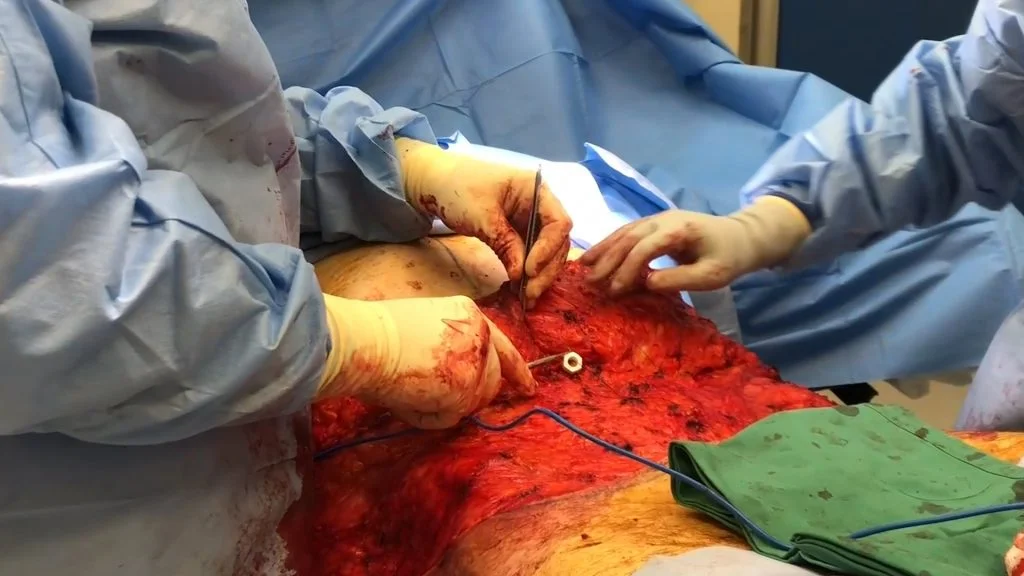
Doctor Bernard will make an incision around your belly button. This frees your belly button stalk so it can be moved. Your navel is tethered to your underlying ab muscles. It acts somewhat like a button on a tufted sofa, holding your tummy skin in place. Freeing your belly button will make it possible to pull and tighten your loose skin as much as possible.
Removing loose skin on your tummy and sides
Next, Doctor Bernard will tighten the skin on your tummy and sides. This is done by cutting off the excess skin and suturing the incision closed. He will measure how much skin to remove on your abdomen and sides before making any cuts. Again, the goal is to remove the right amount of excess skin, not too much or too little. Once your skin is tightened, your abdomen will look flatter and firmer.
Belly button repositioning
Doctor Bernard will create a new hole for your belly button. He will pull your existing belly button stalk through it. In some cases, he will need to amputate a small part of the umbilical stalk if it’s too long.
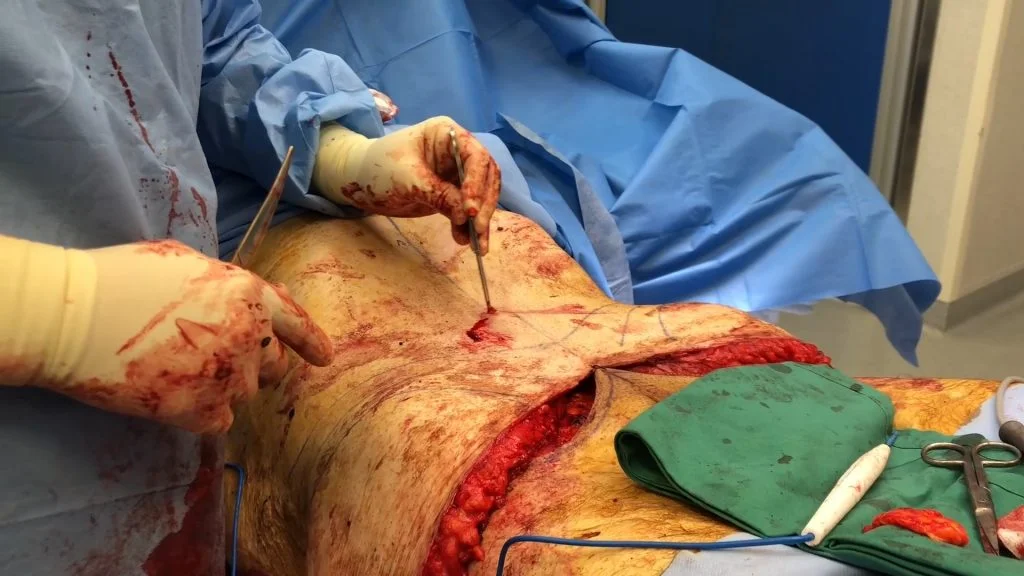
The hole is intentionally oval or irregular shaped. Round belly buttons can constrict, or “close up”. By making your new belly button opening an oval, this defect is unlikely to occur. Contrary to popular belief, most belly buttons are not round. Oval is the most common belly button shape. In a social media survey, Doctor Bernard’s patients rated oval as the most aesthetically pleasing navel shape.
Stitching your belly button in place
He will stitch your belly button in place with dissolving sutures. The sutures will be buried in the surrounding skin as much as possible. This will minimise scarring. He will also apply medical-grade tissue glue. The glue will reduce tension on the sutures and aid in shaping your new navel.
He will also remove a small amount of fat under your belly button. This creates a small dip. Most belly buttons dip inward slightly. A small hood may be added, which is a feature that is commonly seen on natural belly buttons.
Closing the abdominal incision
At this point in the surgery, your excess skin has been removed and tightened all the way around your waistline. Your belly button has been moved and reshaped. It is time to close the incision.
Your incision will be closed in layers. Doctor Bernard will place sutures in your scarpa’s fascia. He incorporates the scarpa’s fascia (a white, tough sheath in your abdominal cavity) in the closure because it can withstand a significant amount of tension. This ensures maximum tightness for the flattest, firmest tummy possible. It also reduces tension on your incision as it heals.
Plication sutures will be applied to the middlemost layers. These sutures will dissolve naturally, so they won’t need to be removed. The plication sutures will be stitched on the top part of your abdomen and then pulled down to your abdominal wall for a tighter result. Plication sutures also support the wound and avoid excessive pulling on your mons pubic area. This is especially important for female patients.
Doctor Bernard will again apply the medical-grade glue for a tight seal. Again, this will reduce gaps in your abdominal tissues, potentially lowering the risk of bruising and seroma.
At this stage, your entire waistline should appear flat and taut 360-degrees around your waistline. Your mons pubis area will be lifted to a more ** position. ** on your tummy, buttocks and thighs should be noticeably **.
Phase 5: Finalising Your Surgery
Bandages
Doctor Bernard will apply bandages. The bandages protect your incision from infection and irritation. Any sterile bandage works fine, but Doctor Bernard prefers PICO Negative Pressure bandages. This soft, battery-powered bandage applies constant, gentle suction on the wound to promote healing. According to the manufacturer, PICO dressings help to stimulate blood circulation and minimise swelling at the wound site. They are also said to lock out 99.9% of bacteria with AIRLOCK™ technology. You will wear the soft PICO dressing for approximately seven days.
Compression garments
Gentle compression helps to minimise swelling after surgery. Compression garments are made of a special stretchy fabric that applies constant, gentle pressure. You will be asked to wear the garment for several weeks. The goal is to reduce swelling and help your skin mould to your new body contours. Compression garments will also take tension off your incision as it heals.
You will wake up from surgery wearing the garment, so you don’t have to worry about what kind of compression garment to buy. Doctor Bernard only uses high-quality compression garments.
Your belt lipectomy is now complete.


